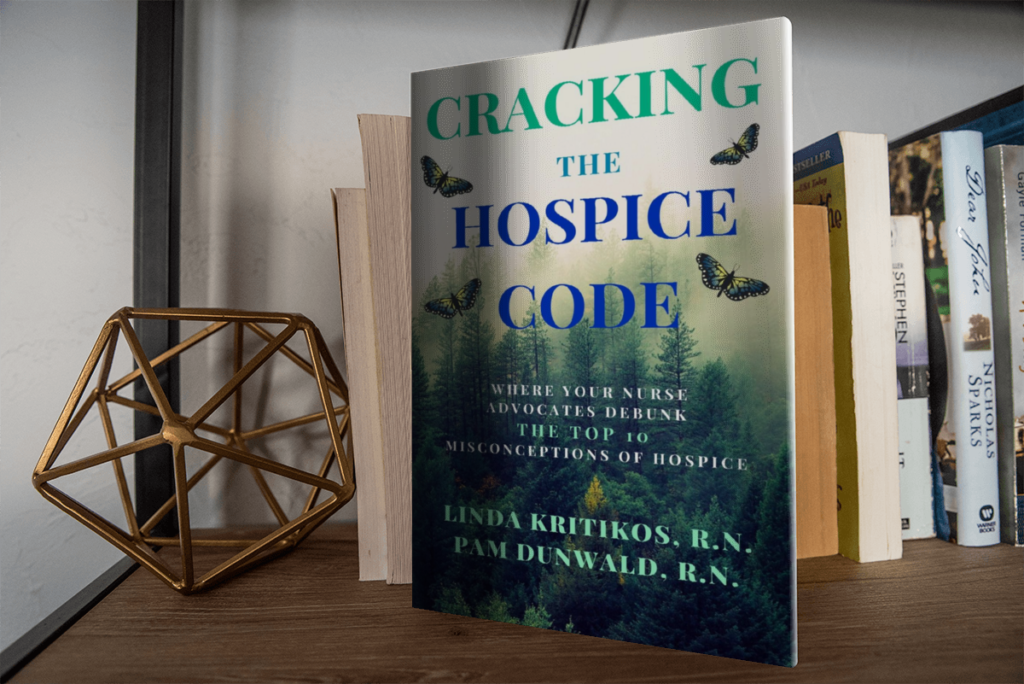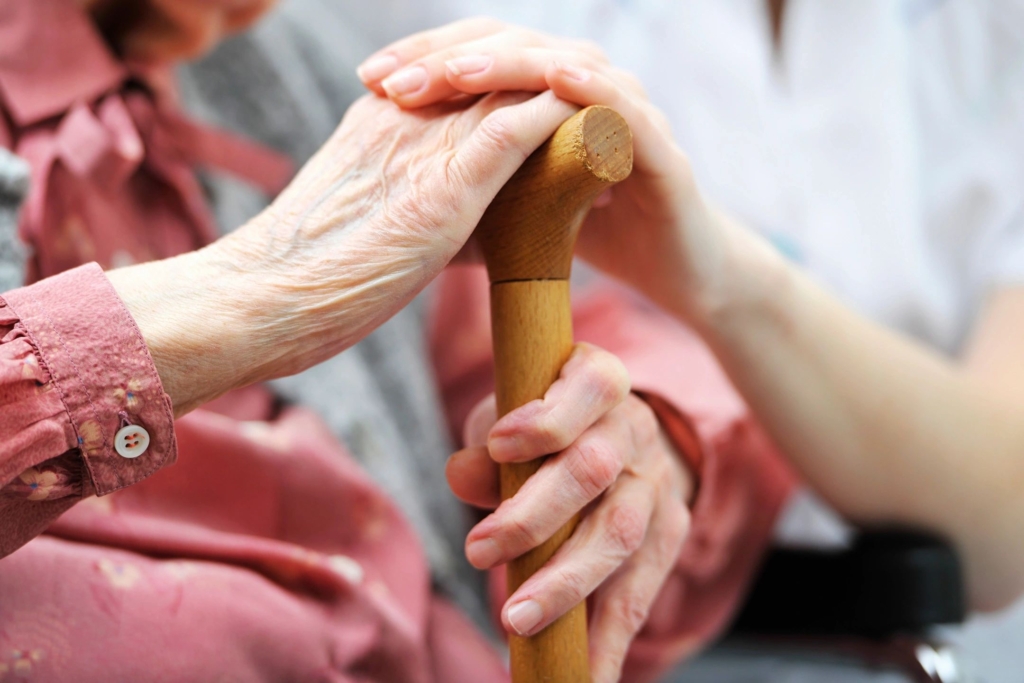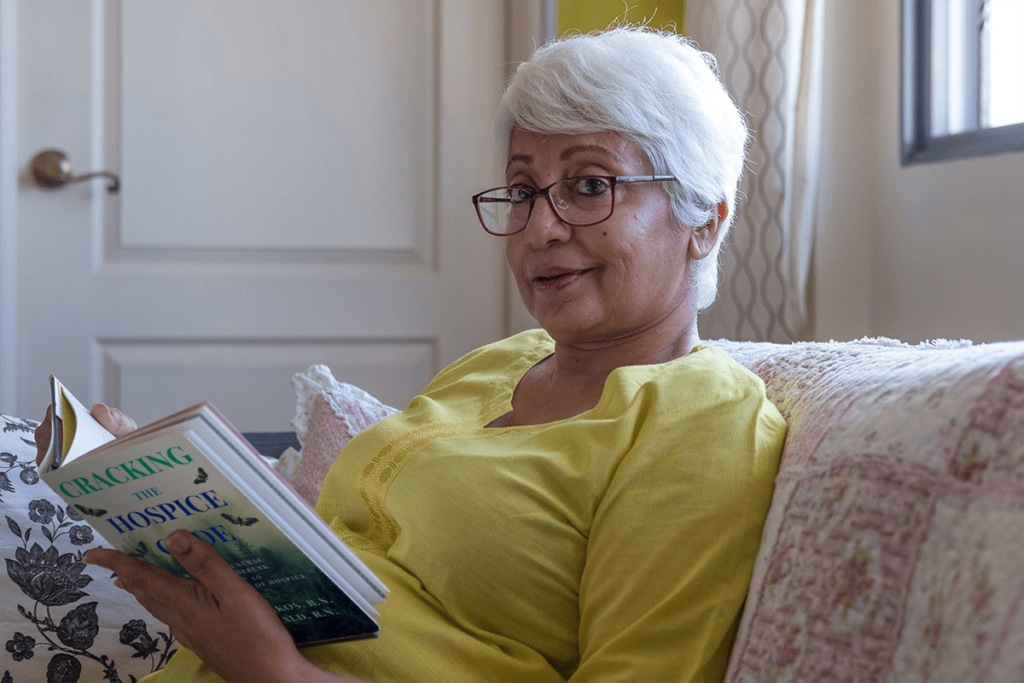
As patient advocates Linda and I both have experience with working in Hospice. What we find is that most people are afraid of Hospice and feel this is a service that is needed at those last few days at the end of life when no other options are available. In our book, “Cracking the Hospice Code, Where Your Nurse Advocates Debunk the Top 10 Misconceptions of Hospice,” we share stories of enlightenment, courage, fear, anger, denial, and joy all the emotions experienced on the roller coaster ride of that final journey in life. It is our goal to share these stories and inspire you to take a more open-minded look at all the benefits of hospice and what it may mean for your family.
First of all, Hospice is a philosophy as much as a level of care provided. Hospice is a choice that one can make when all the continued treatments and trips to the hospital become more of a burden with a negative effect on their perceived quality of life. They want to choose to take a more natural approach. This individual wants to choose quality over quantity.
Part 1 of the book, we take you on a journey through the eyes of some of the most courageous people we have ever met and share their stories of their hospice experience and eventually the final episodes that lead to the end of their life.
In Part 2 of our book, we address in depth the top 10 Misconceptions we have come across when people ask questions regarding hospice. We will provide information to dispel these beliefs and give you a picture of all the good things hospice can do. We will provide information for those looking at hospice as an option for themselves or a family member.

Here is some food for thought. Have you ever said any of these things about Hospice?
Misconception #1: You Only Enroll In Hospice When You Have A Couple of Days Left to Live– The longer you have hospice services on board, the more resources you can take advantage of. You have more time to plan and prepare.
Misconception #2: Hospice Costs Too Much-Hospice is a Free Service for Medicare recipients and most insurance companies have a hospice benefit. Medications, equipment, nurse, aide, chaplain, social work visits are all included.
Misconception #3: All Hospice Does is Speed Up the Dying Process-Once this process starts you can’t speed it up or stop it. You can just manage it.
Misconception #4: I Won’t Be Able to Get Any Type of Treatment Anymore. This is only true for treating the disease process you are admitted to hospice for. If you fall and injure yourself such as breaking a hip, you can still get treatment. Contact your hospice team and someone will meet you at the Emergency Room to discuss plans.
Misconception #5: You Will Starve Me to Death-Once someone embarks on this final journey the body begins to prepare itself for passing. Muscles weaken which includes your throat muscles. This may cause a hoarse voice and difficulty swallowing. Your body begins a natural dehydration process in preparation for passing. If someone asks to eat or drink certainly offer but forcing someone to eat or drink may cause choking.
Misconception #6: Hospice Means Giving Up. Hospice is not giving up. It is accepting the reality of a limited life. Once this mindset can be achieved, hospice can help you live out the rest of your life as happy and as comfortable as possible. It allows you the time to prepare for what is ahead. Maybe writing letters to your children or grandchildren or working on a memory album. It gives you the peace of mind and dignity to have time to live out the rest of your life.
Misconception #7: Once You Are On Hospice You Can’t Go Back. If you feel hospice is not a good fit, you can sign off at any time and go back to the way things were. Some people get better while on hospice and “graduate” because their symptoms become so well-managed. You can go back to hospice at a later time.
Misconception #8: If I Am On Hospice I Loose All Control Over Everything-As long as you are able the decision making belongs to you. The hospice social worker can also help you prepare documents to outline your wishes when you no longer can make your wishes known.
Misconception #9: My Family Will Not Have Any Say So In My Care-Hospice is not only about caring for you it is about providing care and guidance to you family. You are all on this journey together and hospice will address the needs for the entire family unit.
Misconception #10: If You Are On Hospice You Have To Go To A Hospital or Other Type of Facility Instead of Staying Home-Many people stay home on hospice. If there are family members to assist the patient while staying at home one gift that hospice can give is the ability for your loved one to pass in the comfort of their own home. There are hospice facilities and respite care available depending on the needs of you and your family.

Many people wonder what is the difference between Hospice Care and Palliative Care?
Hospice and palliative care are often confused because they both deal with end-of-life issues. But there are some key differences between the two.
Hospice care is typically provided to terminally ill patients who have six months or less to live. The focus of hospice care is on comfort, not cure as well as quality of life.
Palliative care, on the other hand, can be provided to any patient dealing with a serious illness such as an incurable chronic disease such as Chronic Obstructive Pulmonary Disease or Congestive Heart Failure. It can be used alongside curative treatment, and its goal is to improve quality of life by managing symptoms and medications. Palliative care teams typically include doctors, nurses, social workers, and chaplains. They work together to manage symptoms and provide emotional and spiritual support. If you or a loved one is facing a serious illness, it’s important to understand the difference between hospice and palliative care so you can make the best decision for your situation.
Palliative Care programs can be different. Some programs have the Palliative Care provider come to your home. Other programs offer Palliative Care in the clinic the same as seeing your regular doctor. It is important to know what type of program will best suit you and your loved one’s needs.
Often times Palliative Care can be the precursor to hospice. It is not uncommon for Palliative Care and Hospice to have both services covered by the same company which makes an easy transition to when the time might be right to transition to hospice care. You will already have some familiarity with the caregivers and can help ease the change in service.
Palliative Care is when you have a non-curable chronic illness or disease but want to have the best outcomes as possible while actively treating the disease. Hospice comes into play when that chronic disease or cancer has limited your quantity of life. It is not giving up. It is about living your best life for as long as possible. Many people get better on hospice due to the great management of symptoms. Sometimes people “graduate” from hospice because their condition is improving vs. declining. Hospice is always available later on when you need it. You can also stop hospice at any time you choose if you feel this service is not for you, your option is to return to managing your health issues as before you went on hospice care.

Linda and I have a true passion for hospice care and have witnessed the many blessings this type of care can provide. If you want to know more about hospice care and go into more detail on the 10 misconceptions, we encourage you to purchase our book. You will read about real-life stories from our past patients and see exactly what hospice can provide to a patient and their family. We have put together a Free Checklist that will give you some ideas if you or a loved one may be interested in hospice care and if it is an appropriate level of care for the health season you are in.
We are excited to share this book. Our hope is that you may shed a few tears, laugh a few laughs, and feel all the emotions as we take you on the hospice journey and answer your questions along the way. We have shared just a snippet of information on hospice and palliative care. Please reach out if you would like to discuss your personal situation.
We have also attached a consumer guides report on the use of hospice care. This also gives you a unbiased look at what hospice is how it may be of benefit. When to Start Hospice Care – Consumer Reports
If you or a loved one is in a position to be considering hospice our heart goes out to you as we know these choices are not easy ones to make. Feel free to reach out to Your Nurse Advocate Consulting and we can assist you with any individual needs or questions you may have. Request a complimentary 30-minute discovery call with Linda HERE for and we can discuss your needs. Please choose this link for a complimentary 30-minute discovery call with PAM.
As always, thanks for stopping by and taking a few minutes out of your busy day to spend time here with us!
Take care,
Pam and Linda





